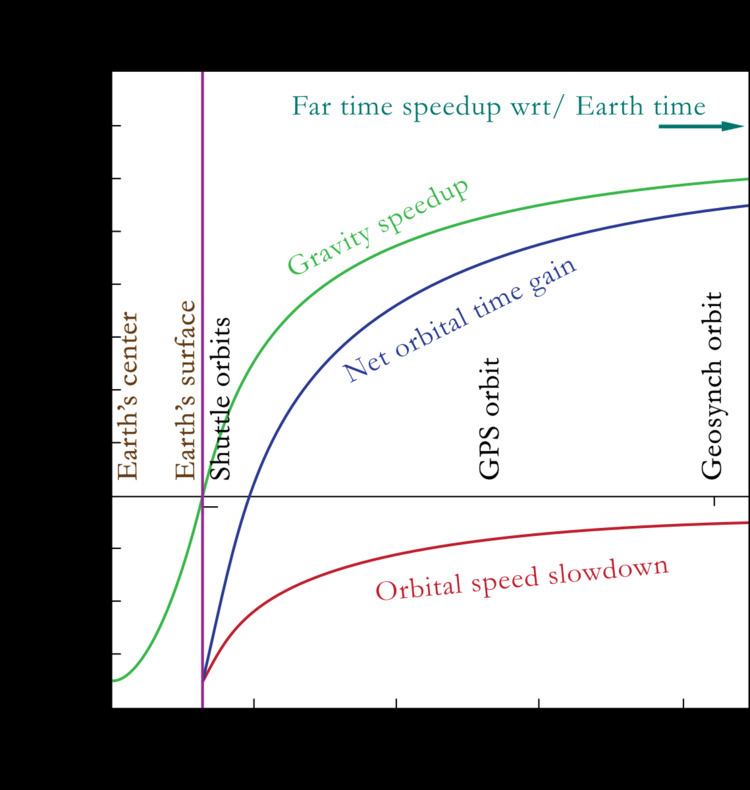 | ||
Gravitational time dilation is a form of time dilation, an actual difference of elapsed time between two events as measured by observers situated at varying distances from a gravitating mass. The weaker the gravitational potential (the farther the clock is from the source of gravitation), the faster time passes. Albert Einstein originally predicted this effect in his theory of relativity and it has since been confirmed by tests of general relativity.
Contents
- Definition
- Outside a non rotating sphere
- Circular orbits
- Important features of gravitational time dilation
- Experimental confirmation
- References
This has been demonstrated by noting that atomic clocks at differing altitudes (and thus different gravitational potential) will eventually show different times. The effects detected in such Earth-bound experiments are extremely small, with differences being measured in nanoseconds. Relative to the earth's age in billion of years, the earth's core is effectively 2.5 years younger than the surface leading to a paradox of alignment with the celestial sphere due to the rotation of the earth. Demonstrating larger effects would require greater distances from the Earth or a larger gravitational source.
Gravitational time dilation was first described by Albert Einstein in 1907 as a consequence of special relativity in accelerated frames of reference. In general relativity, it is considered to be a difference in the passage of proper time at different positions as described by a metric tensor of spacetime. The existence of gravitational time dilation was first confirmed directly by the Pound–Rebka experiment in 1959.
Definition
Clocks that are far from massive bodies (or at higher gravitational potentials) run more quickly, and clocks close to massive bodies (or at lower gravitational potentials) run more slowly. For example, considered over the total lifetime of the earth (4.6 Gyr), a clock set at the peak of Mount Everest would be about 39 hours ahead of a clock set at sea level. This is because gravitational time dilation is manifested in accelerated frames of reference or, by virtue of the equivalence principle, in the gravitational field of massive objects.
According to general relativity, inertial mass and gravitational mass are the same, and all accelerated reference frames (such as a uniformly rotating reference frame with its proper time dilation) are physically equivalent to a gravitational field of the same strength.
Let us consider a family of observers along a straight "vertical" line, each of whom experiences a distinct constant g-force directed along this line (e.g., a long accelerating spacecraft, a skyscraper, a shaft on a planet). Let
where
For simplicity, in a Rindler's family of observers in a flat space-time, the dependence would be
with constant
On the other hand, when
See Ehrenfest paradox for application of the same formula to a rotating reference frame in flat space-time.
Outside a non-rotating sphere
A common equation used to determine gravitational time dilation is derived from the Schwarzschild metric, which describes spacetime in the vicinity of a non-rotating massive spherically symmetric object. The equation is
where
To illustrate then, without accounting for the effects of rotation, proximity to the Earth's gravitational well will cause a clock on the planet's surface to accumulate around 0.0219 fewer seconds over a period of one year than would a distant observer's clock. In comparison, a clock on the surface of the sun will accumulate around 66.4 fewer seconds in one year.
Circular orbits
In the Schwarzschild metric, free-falling objects can be in circular orbits if the orbital radius is larger than
Important features of gravitational time dilation
Experimental confirmation
Gravitational time dilation has been experimentally measured using atomic clocks on airplanes. The clocks aboard the airplanes were slightly faster than clocks on the ground. The effect is significant enough that the Global Positioning System's artificial satellites need to have their clocks corrected.
Additionally, time dilations due to height differences of less than 1 meter have been experimentally verified in the laboratory.
Gravitational time dilation has also been confirmed by the Pound–Rebka experiment, observations of the spectra of the white dwarf Sirius B, and experiments with time signals sent to and from Viking 1 Mars lander.
